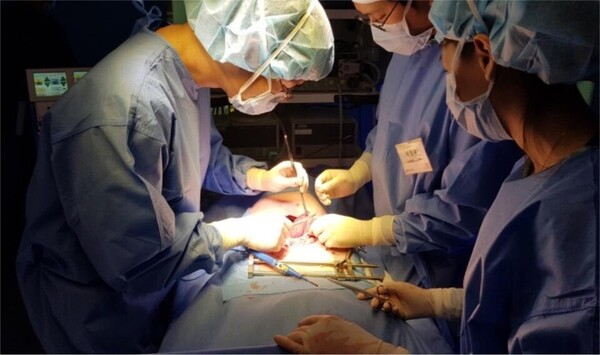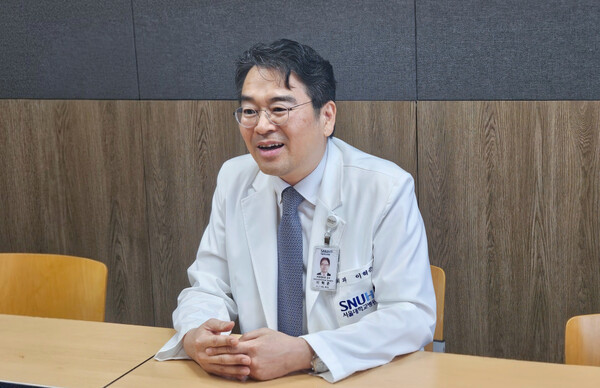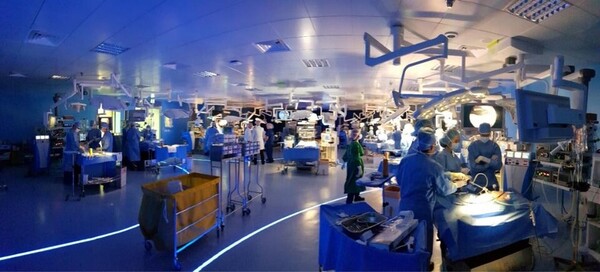“Give us 30 pigs, and don't cut there. We'll do the cutting.”
The butcher stopped cutting at this unheard-of request. The buyers chased him through the workshop when he offered the usual slaughtered pig.
“This is not good enough. We want a whole hog, from the esophagus to the stomach to the small intestine,” the customers said, eyeing the hog on the rack. “From there, we'll cut it ourselves.” After taking away 30 hogs, the customers kept coming back. The order was the same: “We want the esophagus, stomach, and small intestine in one piece.”

This is a story from 20 years ago when Professor Lee Hyuk-joon, who had just completed his surgical fellowship program at Seoul National University Hospital, went to a pig slaughterhouse in Bucheon, Gyeonggi Province, with his junior colleagues in search of training materials.
That may sound like an old folktale to today’s surgeons, who are on the cutting edge of the medical world, marked by AI simulation training and robotic surgery.
However, for Lee, that story is not a myth -- it’s a matter of historical fact. The Korean Surgical Skill Study Group (KSSSG), which celebrated its 20th anniversary this year, started there.
Back then, the only way to practice surgical intestinal anastomosis was to go into the operating room and perform the procedure on patients.
The professors who guided trainee doctors and junior physicians who had to hold the scalpel were under tremendous pressure. There was also a sense that it violated the ethics of patient care. There was a consensus that minimal training was necessary before entering the operating room. In 2005, the KSSSG was founded by Dr. Yang Han-kwang, a former professor of surgery at Seoul National University Hospital (and director of the National Cancer Center). Today, there are about 500 members who specialize in surgery.
“It is rare worldwide that professors voluntarily gathered to create a training program for trainee doctors. Some looked at professors who enthusiastically trained residents as unusual- it's more work and less return- but it was a group of genuine medical professionals. Even professors who joined the group later say, “I wish I had gotten involved sooner.”

20 years of surgical skill study has ‘realized the value of training itself’
What started as an intestinal anastomosis has grown to six modules. Starting with the basics of intestinal anastomosis, laparoscopic surgery, and cadaveric dissection, the modules have expanded to include ultrasound, endoscopy, critical care, and traumatology. The cadaveric anatomy training program was introduced in 2021 after signing an agreement with the Catholic International Bioskills Education Center (CIBEC) at the Catholic University of Korea Seoul St. Mary's Hospital.
The KSSSG was the first group to incorporate cadavers into the training of junior doctors, not specialists. Similar programs are also hard to find worldwide. “Once we open the lab, trainee doctors lose track of time. They don't even think about going home,” Lee said.
In 2010, the Korean Surgical Society (KSS) mandated surgical skills training, and all surgical residents were required to complete the KSSSG’s training program. In response to the explosive demand, two KSSSG local chapters opened in Osong, North Chungcheong Province, and Songdo, Incheon. Another one will open within the Daegu-Gyeongbuk Advanced Medical Complex next year. In addition, the KSSSG also plans to develop a robotic surgery module.
There are also challenges -- especially the lack of infrastructure for endoscopy and ultrasound training.
“Surgery is important, but I would like to educate people on what they can and are doing in surgery at a practical level by moving beyond the level of ‘I have been there and I have done it once.’”
The regret felt by surgeons soon becomes the regret of patients who receive treatment,” Lee said. “I hope that each training hospital, not just the medical associations and academic groups, will have an environment where they can teach surgical skills, including endoscopy and ultrasound.”
The organization that started with “teaching trainee doctors properly” has existed for over 20 years. It is amid a time when “essential medical” manpower and resident training issues are mixed. Although junior doctors have left the field for more than a year, the organization is preparing for the day when they will return and start practicing again.
“Twenty years ago, the idea of not just using manpower but putting value on training trainee doctors was considered a huge innovation. The government is only now looking at the junior doctor crisis after a medical turmoil, but we have been preparing for decades. This 20th anniversary is no less relevant today,” Lee emphasized.

'Teaching hospitals must truly teach -- by guaranteeing surgical training'
No matter how much you train with pigs and cadavers, performing surgery is a different matter. Surgical “less profitable” departments are asked to operate “more, faster, with fewer people.” Professors are busy with surgeries that last into the night, and it's difficult for medical residents to gain experience. Patients also have a hard time understanding “why Seoul National University Hospital is a teaching hospital and why junior doctors perform the surgeries for me and my family because the hospital has forgotten its role as a teaching hospital.
“It's time for the Korean society to realize what a teaching hospital is,” Lee said. He stressed that patient and social awareness should change and institutional improvements are needed. It is necessary to ensure dedicated surgical opportunities for training and to create an environment where junior doctors can actively participate.
“A teaching hospital is a 'team system.' It's a place to collaborate, develop, and pass down generations. The medical community should promote this, and society should recognize and cooperate. The same goes for the hospital, which should be run as a teaching hospital. Maybe there should be a percentage of surgeries that are for training purposes. We need specific guidelines.”
Just as surgeons are not entering the operating room, “surgeons are leaving the operating room, and medical students are losing their passion for surgery,” he said.
“The surgical department is inherently enjoyable and rewarding, and it's also a place where you save people in 'one-shot' deals,” Lee said. “And that surgical department is in crisis now. Even if we have been preparing for the last 20 years, we can only survive with social and policy support. I hope we can keep the joy of saving people with surgery and honing our skills.”

